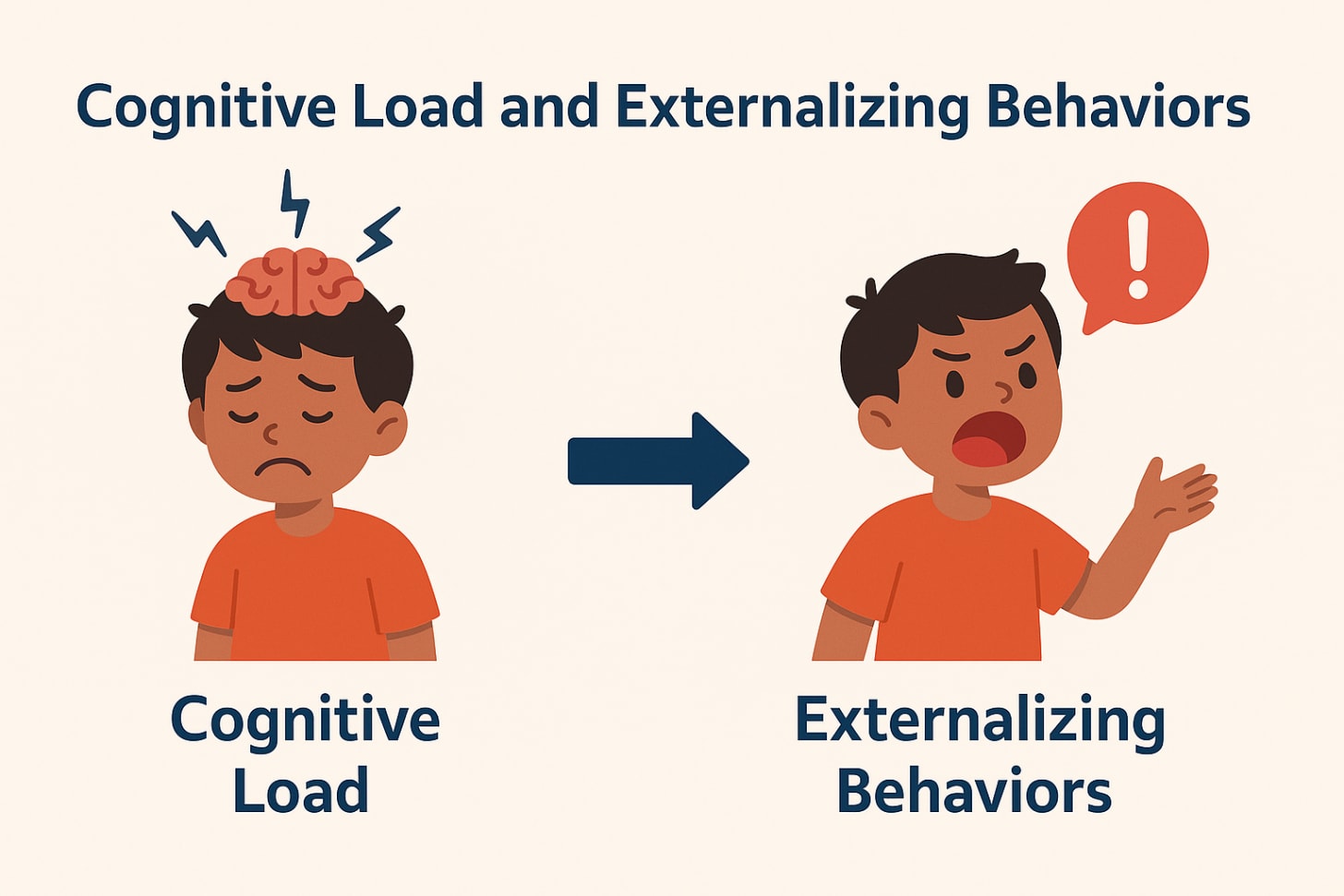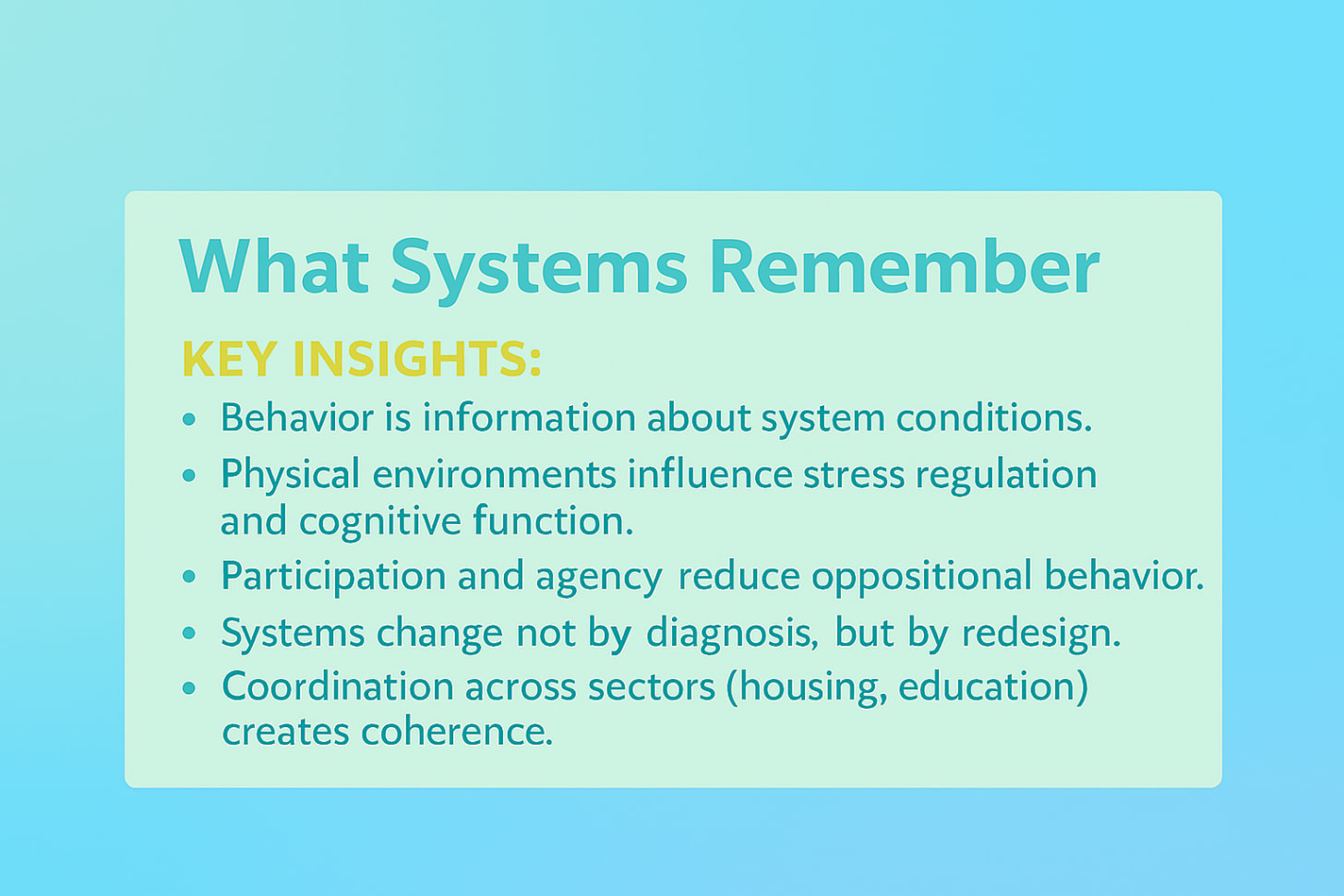Childhood behavior often seems unpredictable (e.g., tantrums, silence, defiance). But these responses follow patterns. And those patterns become legible when we zoom out—not just from the child, but from the systems around them.
Behavior, in this view, is not a failure to cope, but a kind of information. As Bateson put it:
“… a difference which makes a difference.”
The studies in this issue of Child and Adolescent Mental Health track those differences: how parenting structure, executive function, environmental design, and community cohesion all shape the signals children send and receive.
The conclusion is hard to ignore:
Behavior follows familiarity. Systems define what’s familiar.
These findings aren’t just theoretical. They have clear implications for how we design classrooms, public spaces, support systems, and policies. So, the following isn’t another trite argument for more empathy, but a broader call for better systems thinking. Specifically, what follows is a synthesis of recent research, policy, and community practice, showing how behavior reflects what systems make familiar.
Children learn behavior through structured interaction (i.e, not just through warmth, but through patterned participation). In one study, autistic preschoolers showed stronger long-term social growth when both parents engaged in triadic interactions. Those results align with Vygotsky’s insight that development doesn’t begin inside the child, but emerges through coordinated social activity. The child’s behavior, in this case, is a reflection of the interactional system, rather than merely an internal state.
In another study, externalizing behaviors were closely linked to cognitive load. Children who appeared oppositional often had impaired working memory and reduced executive function. Their behavior was not intentional defiance but a sign of reduced processing capacity under stress.
Medication sometimes helped, but not always for the expected reasons. In cases of pediatric mania, antipsychotics reduced symptoms even when diagnostic categories overlapped with ADHD and oppositional defiant disorder (ODD). The effect wasn’t tied to diagnostic precision, but simply to relief from dysregulation. As such, across these cases, behaviors reflected not internal pathology but system-level stress (e.g., relational, cognitive, environmental).
Environmental context has measurable effects on cognitive and emotional development. In dense urban areas with limited vegetation (what some researchers call "gray space"), children exhibit higher rates of behavioral dysregulation, reduced attentional capacity, and elevated stress markers. These outcomes are not random; they correlate with specific environmental conditions (e.g., noise, air pollution, visual monotony, and low natural light).
By contrast, exposure to green space (trees, parks, natural views) has been linked to lower rates of anxiety and depression, improved executive function, and greater prosocial behavior. These effects are strongest in lower-income communities, where baseline stress is higher and buffering factors fewer.
When children participate in designing their environments, such as in the Dundee youth space project, behavior changes again. Co-authorship increases engagement and reduces oppositional behavior—not due to novelty, but due to increased perceived agency and safety.
Nature-based interventions in primary schools produce similar results. Programs that deliberately integrate outdoor learning show gains in attention, emotional regulation, and peer interaction, particularly among students with existing challenges.
The system doesn’t just operate within space. It adapts to it. As architect Christopher Alexander observed, built environments embed recurring patterns that shape behavior and experience. When schools, neighborhoods, and public spaces follow patterns that support coherence, safety, and interaction, those patterns reinforce attention, regulation, and trust. When they reflect fragmentation, over-stimulation, or neglect, the system absorbs those qualities too—often as stress and dysregulation.
Despite its nearly universal attraction, the debate between urban and rural environments might be missing the point. Mental health outcomes are shaped less by geography than by design—by how environments are structured, who they include, and what they allow.
A small, connected neighborhood with access to nature and services can be more supportive than a large, isolated property. The key factors are access, safety, routine, and perceived agency.
In Manchester, Ravetz (2025) examined the Local-wise initiative, which aimed to improve youth mental health not through clinical treatment, but through coordinated structural change. The approach brought together schools, youth leaders, housing authorities, law enforcement, and local government to implement what they called “collective local intelligence.”
Their interventions included:
Rights-based curricula in schools
Youth forums with regular input into local decisions
Community policing focused on presence and relationship, rather than enforcement
Parks redesigned for shared use, including food events and sanctioned graffiti
Housing policies focused on stability and community identity
Young people were active participants in the planning process. These weren’t symbolic gestures; they were structural reforms designed to increase coherence across domains of daily life.
The outcome was not a single program, but a change in baseline conditions: fewer behavioral escalations, greater trust in institutions, and stronger cross-sector coordination.
As systems theorist Donella Meadows observed, the most effective interventions don’t tweak inputs; they shift the structure’s goals, rules, or feedback loops. The Local-wise project didn’t just create new programs. It redefined what the system was optimizing for: coherence over containment and contribution over compliance.
The Manchester example is one instance of a broader pattern. When systems shift their structure and goals—when they create coherence instead of friction—individual behavior follows. This isn’t magic, but intelligent, deliberate, and effective infrastructure.
Seen it firsthand?
I’m curious how this resonates with your own work or experience.
Share your thoughts, especially if you’ve seen systems shift like this.
Across all studies, the pattern is clear:
Behavior reflects system-level conditions.
Systems encode memory, not through neurons, but through routines, defaults, and design. Expectations accumulate in forms, schedules, policies, and environments.
Every part of a system communicates something:
A classroom layout.
An intake form.
A hallway.
A missing tree.
A locked door.
These are not passive or inert details. They shape behavior.
So, the practical question then is not: how do we treat behavior?
It’s: what does the system teach, expect, and reinforce?
If we want different outcomes, we need to change our habitual approaches to system’s, so that we:
Design for clarity over control.
Make participation structural, rather than symbolic.
Treat environment as a functional variable, rather than a backdrop.
Systems are modifiable. They can adopt new defaults.
As Herbert Simon wrote,
“To design is to devise courses of action aimed at changing existing situations into preferred ones.”
The implication is clear: if we want to change behavior, we must treat systems as design problems. And when we change those designs with intention—toward clarity, participation, and coherence—we enable different behavior to emerge.
Trauma has memory. But so do systems.
Hallways, forms, schedules, rules—each one teaches. Often unintentionally.
Children read these cues. A tantrum might not be defiance. It might be a question: Is this a place that understands me?
So, our task isn’t just to manage behavior, but to examine what the system keeps modelling: what defaults it encodes, what expectations it communicates, often without review.
As Ivan Illich warned, institutions can easily lose sight of care when structure becomes an end in itself. When the goal is control, systems often reproduce the very problems they’re meant to solve.
But systems can change. Defaults can be redesigned. And when that happens, behavior often changes too. Because what we call a disorder may sometimes be nothing more than a system’s message, reflected back through the body of a child.
Indeed, just as algorithms behave according to training data and system inputs, so do children. When we see unexpected outputs, we shouldn't blame the model. We should check what it’s been exposed to. The patterns may look like noise at first. But if we listen closely, we may hear what the system has been trying to say all along.
If this gave you something to think about: Share it with someone designing, leading, or rethinking the systems we live in.
Q: Is this just another way of saying “kids will be kids”?
No. Children’s behavior is not random; it reflects the patterns of the systems they inhabit: family, school, culture, media. Recognizing those patterns helps us move beyond blame or frustration and toward curiosity and constructive change.
Q: So… it’s not about the child? It’s about the environment?
It’s both. Children bring their own temperaments, histories, and neurobiology. But those traits interact with expectations, norms, and feedback loops in their environment. Behavior is rarely the product of one factor. It’s the outcome of complex, non-linear interactions.
Q: What’s the practical takeaway for parents or teachers?
Zoom out. When a child’s behavior seems puzzling or challenging, ask: What is this child learning to expect? What system are they adapting to? Often, small changes to environment, routine, or response patterns can shift behavior more sustainably than direct confrontation.
Q: Does this mean we shouldn’t set boundaries?
Boundaries matter. But they’re most effective when they are consistent, developmentally appropriate, and part of a system that helps the child feel safe, seen, and capable.
Q: How does this connect to adult behavior?
We never outgrow patterned participation. Adults, too, act from expectation, system memory, and stress regulation. The same principles apply: context shapes conduct. Understanding this can soften our judgments—not only toward children, but toward ourselves and others.
Q: Where should I start?
Start by noticing. Instead of asking, “What’s wrong with this child?” try: “What problem is this behavior trying to solve?” From there, look at the wider web (relationships, rhythms, narratives) that may be shaping the context and the conduct.
Further Reading
.png)





